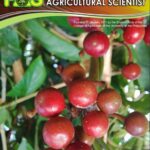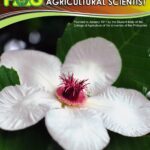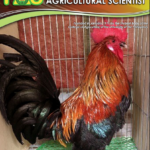Vol. 103, No. 3 (Sep 2020)
Canna lily (Canna x generalis L.H. Bailey & E.Z. Bailey) is a genus of flowering plants native to the tropics and subtropics. More than 400 years ago, Cannas have been grown accidentally, intentionally hybridized, and traded among gardeners. As its flowers come in various blends of mixed colors and lustrous attractive foliage, Canna is one of the most popular ornamental plants used widely in landscaping settings, gardens, border plantings in parks and patios where it serves as a living fence and windbreak. Breeding and selection of novel, attractive, high-quality and climate-resilient ornamental crops are necessary to cater to the needs of the booming ornamental industry in the Philippines. To achieve such improvements and create variation, there is a need to evaluate the morphological and cytogenetic characteristics of the crop of interest such as Canna, its cultivars and putative hybrids if they are variable enough in terms of plant height, staminode size and staminode color – characteristics which are of great value to ornamental breeders and enthusiasts.
Categories
Articles
Physicochemical Characteristics of Soils in a Salt-affected Lowland Rice Environment and Implications to Productivity
Jocelyn D. Labios, Joy Eloiza M. Rosales and Pearl B. Sanchez
There is lack of useful information that provides thorough understanding of the extent and severity of soil problems in salt-affected coastal lowland rice areas and their effect on farmer productivity. Soil physicochemical characterization was conducted in eight coastal rice fields in Balayan, Batangas, Philippines with varying distances from a source of saltwater intrusion. Soil, plant, and water samples were collected and analyzed from August 2014 to April 2015. Key farmer interviews were conducted. Soil organic matter was high in the wet season (WS) until the dry season (DS). Levels of soil nitrogen and phosphorus (P) were high at the end of WS and DS, indicating residuals from fertili...
There is lack of useful information that provides thorough understanding of the extent and severity of soil problems in salt-affected coastal lowland rice areas and their effect on farmer productivity. Soil physicochemical characterization was conducted in eight coastal rice fields in Balayan, Batangas, Philippines with varying distances from a source of saltwater intrusion. Soil, plant, and water samples were collected and analyzed from August 2014 to April 2015. Key farmer interviews were c...
Development of a Cell Suspension Protocol for Abaca (Musa textilis Nee ‘Inosa’)
Evalour T. Aspuria, Emmanuel L. Bernardo and Maria Angie D. Tayangona
A protocol for the establishment of embryogenic cell suspension in abaca was developed based on the International Network for the Improvement of Banana and Plantain (INIBAP) procedure for Musa. Meristematic buds from shoot cultures were excised and cultured on P5 medium for several cycles until ‘scalps’ formed. These scalps were then used to produce embryogenic complexes (ECs) in 2,4-D-containing media. Discrete primary somatic embryos (SEs) were observed on ECs 3–4 wk after initial culture. After 6 mo, 6 % of the 150 inoculated scalps formed into ECs that had at least 10 SEs. These were then used to commence cell suspensions. Nine liquid media formulations were tested, and only M2 medium...
A protocol for the establishment of embryogenic cell suspension in abaca was developed based on the International Network for the Improvement of Banana and Plantain (INIBAP) procedure for Musa. Meristematic buds from shoot cultures were excised and cultured on P5 medium for several cycles until ‘scalps’ formed. These scalps were then used to produce embryogenic complexes (ECs) in 2,4-D-containing media. Discrete primary somatic embryos (SEs) were observed on ECs 3–4 wk after initial culture. ...
Morphological and Cytogenetic Characterization of Four Canna (Canna x generalis L. H. Bailey & E. Z. Bailey) Cultivars and Two Putative F1 Hybrids
Juareyn L. Ondoy, Merlyn S. Mendioro, Pablito M. Magdalita, Celia B. Dela Viña and Maria Cecilia S. Reamillo
Four Canna cultivars (C. ‘Moonbeam’, C. ‘Madeira,’ C. ‘Wintzer’s Colossal’, C. ‘Alphonse Bouvier’) and two putative F1 hybrids of C. ‘Wintzer’s Colossal’ and C. ‘Alphonse Bouvier’ (coded as H3R1 and H3R2, respectively) were evaluated for their morphological and cytogenetic characteristics. Among the morphological parameters reckoned were plant height, culm/stem diameter, flower diameter, flower color, inflorescence length, staminode length and thickness, leaf length, leaf width and leaf thickness. Acetocarmine squash technique was used to determine the chromosome number and chromosome behavior at meiosis I and II. Pollen viability was tested using I2KI test and TTZ test which was further ...
Four Canna cultivars (C. ‘Moonbeam’, C. ‘Madeira,’ C. ‘Wintzer’s Colossal’, C. ‘Alphonse Bouvier’) and two putative F1 hybrids of C. ‘Wintzer’s Colossal’ and C. ‘Alphonse Bouvier’ (coded as H3R1 and H3R2, respectively) were evaluated for their morphological and cytogenetic characteristics. Among the morphological parameters reckoned were plant height, culm/stem diameter, flower diameter, flower color, inflorescence length, staminode length and thickness, leaf length, leaf width and leaf thick...
Isolation and Characterization of Bioactive Compounds from Seeds of Ipil-ipil (Leucaena leucocephala) and Its Antifeedant Activity Against the Third Instar of Common Cutworm (Spodoptera litura)
Elmira Emery R. Medina, Annabelle T. Abrera, and Marlon N. Manalo
Bioactive compounds from ipil-ipil (Leucaena leucocephala) seeds were isolated using solvent extraction and silica gel column chromatography. Antifeedant activities of the crude ethanolic extract, chromatographic fractions and crystalline isolate were tested on third instar larvae of the common cutworm (Spodoptera litura). Dual choice assay using 10 μg cm-2 applied on both adaxial and abaxial parts of castor (Ricinus communis) leaves showed that the crystalline isolate had the highest activity, with percentage relative feeding inhibition of 79.93 ± 1.00%. The very high melting point, together with data from chemical and spectroscopic analyses, suggest that the isolate is a saponin-contain...
Bioactive compounds from ipil-ipil (Leucaena leucocephala) seeds were isolated using solvent extraction and silica gel column chromatography. Antifeedant activities of the crude ethanolic extract, chromatographic fractions and crystalline isolate were tested on third instar larvae of the common cutworm (Spodoptera litura). Dual choice assay using 10 μg cm-2 applied on both adaxial and abaxial parts of castor (Ricinus communis) leaves showed that the crystalline isolate had the highest activit...
Formulation of Larvicide from Capsicum frutescens (Linn.) Fruit Extract Against Aedes aegypti (L.)
Marie Claire Soria, Femina Grace Argonza, Christine Claros, Noel Quiming, Michael Russelle S. Alvarez and Bienvenido Balotro
The crude ethanolic extract of Capsicum frutescens fruit was used in the formulation of larvicidal granules. The extract was first screened for phytochemical content and larvicidal activity against Aedes aegypti. Five trial formulations were developed using different combinations of excipients identified to be compatible with the active extract. These formulations were evaluated using Quality by Testing (QbT) Method (organoleptic evaluation, moisture content, powder flow property, particle size distribution, dissolution in water and larvicidal bioactivity). The C. frutescens extract (500 ppm) killed 100% of the test larvae after 24 and 48 h. Phytochemical analysis revealed the presence of...
The crude ethanolic extract of Capsicum frutescens fruit was used in the formulation of larvicidal granules. The extract was first screened for phytochemical content and larvicidal activity against Aedes aegypti. Five trial formulations were developed using different combinations of excipients identified to be compatible with the active extract. These formulations were evaluated using Quality by Testing (QbT) Method (organoleptic evaluation, moisture content, powder flow property, particle si...


